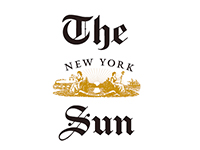
THE NEW YORK SUN
THE FIRST RAINBOW: COLOUR BEFORE COLOR
William Myers
Martin Parr is to contemporary British photography what Puck is to the characters lost in the forest in Shakespeare's "Twelfth Night": a source of mischief and enchantment. His disruptive intentions were on display at the Hasted Hunt Gallery last Wednesday evening, when he moderated a program about "Colour Before Color," the gallery's current exhibition, which he curated. The gallery set up three dozen chairs for the expected audience, but about twice as many people showed up. It is testimony to the respect Mr. Parr commands in the photographic community, and to his Puckish wit, broad sympathies, and extensive knowledge, that the overflow crowd was content to stand or sit on the floor during the presentation. Typically, he let others do most of the talking.
Mr. Parr wants the world to know that European photographers were engaged with color before the landmark exhibition of color photographs by William Eggleston that John Szarkowski organized in 1976 at the Museum of Modern Art. Because of the prestige of MoMA and Mr. Szarkowski, that stunning exhibition legitimated color (the American spelling) photography as an art form in America. Mr. Parr has assembled 48 colour (the British spelling) photographs by six European photographers taken before the 1976 Eggleston exhibition to show they, too, were accomplished, even if not appreciated. He makes his point quite convincingly.
Two of the artists were with him at the Wednesday gallery talk. Peter Mitchell, an Englishman, spoke about the spectacular indifference by the art world to the pictures he took in Leeds in the 1970s. He shot formal portraits of small-business owners standing in the doorways of their little shops in this decaying industrial city. "My Zip code happens to be one of the worst in England," he said. "I'm quite proud of that." The use of muted earth tones taken on overcast days gives his pictures a valedictory feel, which is offset by the slightly humorous "carry on" attitude of his subjects.
Carlos Pérez Siquier, a Spaniard whose daughter interpreted for him, explained the political hazards he faced in the 1960s, during the dictatorship of Generalissimo Francisco Franco, for doing something the government thought of as suspiciously weird: taking art photographs in color. (In a dictatorship, the regime has a monopoly on doing weird.) His pictures, extreme close-ups of body parts of people on the beach, strike us as totally non-political. They are not unlike those Leon Levenstein took at Coney Island in black and white, except that in Mr. Siquier's, sunburned skin contrasts with fluorescent bathing suit colors. "Muñeca" (1974) studies layers of eye makeup like archaeology.
The other photographers in the exhibition are John Hinde (English), Luigi Ghirri (Italian), Ed Van Der Elsken (Dutch), and Keld Helmer-Petersen (Danish). The work of these artists is quite varied. Mr. Helmer-Petersen selfpublished a book titled "122 Colour Photographs" as early as 1947. His Modernist pictures isolate forms and colors into simple abstractions: a black number 6 painted on a brown and red wooden fence, a stack of sand-colored bricks, a steel plate painted battleship gray. He is clearly trying to come to grips with the new medium by reducing his images to the most basic elements.
Many of Ghirri's pictures from the 1970s are also quite simple, but the colors are more muted, and the content more complex. "Moderna" (1972) uses color with the delicate touch Saul Leiter developed; through frosted glass windows set in pale green steel doors we see two figures, one with a dim orange cast. The picture is affecting although modest, but in black and white it would hardly be a picture at all. Several of Ghirri's images are witty with color highlighting the jest. "Lido di Spina" (1972) shows a gray television set sitting on a shelf in a room with plain white walls; the cloth covering the shelf and the room's curtains are orange. The orange is a piquant fact.
One area where color was used early on was in commercial photography. Hinde's postcard company was using color in the late 1960s, when he picked up a commission to photograph Butlin's holiday camps. It took great technological ingenuity for his staff to produce the images they did of these Disneyesque amusement parks, but no one thought of the results as art: no one until Parr. Like Puck anointing the lovers' eyelids to alter their perception, Mr. Parr insists that Hinde's somewhat gaudy, slightly surreal images be considered as art.
The deep saturated reds from the neon signs in "Butlin's Filey: Night Scene" (c. 1970), taken by Edmund Nagele, one of Mr. Hinde's photographers, are reflected and liquefied in rain puddles in the shopping center parking lot. "Butlin's Ayr: Lounge Bar and Indoor Heated Pool (Ground Level)" (c. 1970), taken by Elmar Ludwig, has vacationing families sipping sodas next to windows that look into the blue pool. Goldfish are suspended in the windows and a swimmer hovers in one like a humanoid specimen trapped in an aquarium. The picture is fun, there is lots of interesting period detail, and there are certainly pleasures to be had in looking at it, but to my sensibility it lacks the valence of art. Puck, for all his charm, made mistakes.
The question of whether or not any work qualifies as art can quickly disintegrate into a matter of druthers, or ascend to a lofty discussion of philosophy. For purposes of this review it is more important to say that Martin Parr has performed a valuable rescue operation. We are fortunate to have these neglected photographers presented for our consideration.